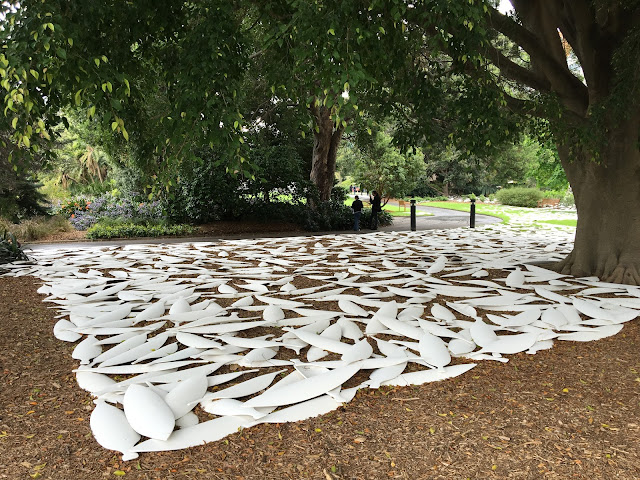I had a rather unexpected, almost obsessive response to Jonathan Jones' installation at the Royal Botanic Gardens, Sydney last year.
It touched me in ways that I'm still finding hard to catch and define.
My fascination kicked in at several levels:
the fire
the architecture
the history
the cultural aspect
the loss
the healing
the blending of histories
the time & place....
In 1879 Sydney hosted the International Exhibition.
A specially designed building was erected on the edges of the Botanic Gardens to house the exhibition. It was grandly called the Garden Palace.
Tragically the Garden Palace and everything inside was destroyed by fire in 1882.
Stored inside was a huge collection of Gadigal artefacts of cultural and historical significance.
Over a hundred years later, Jones went searching for some of the cultural material from where his family came from. He discovered that most of it was destroyed in the Palace Garden fire.
The sense of loss and forgetting around this event spurred Jones on to find a way to reconnect and understand what happened here.
" Perhaps the fire was a kind of cultural burn, regenerating the site for future generations."
The project put together an information booklet for visitors.
In it Jones said,
"as I've worked on the project, the garden palace has become a symbol for the repercussions of forgetting. So many people I've spoken to about the project hadn't known the history of this enormous building that once dominated Sydney's skyline both physically and conceptually. I've begun to question what else we can forget as a community, if something so grand and visible and spoken about has disappeared from our vision. Aboriginal communities have often been the victims of Australia's ability to forget. In this way the Garden Palace became a fault line in the nation's memory, which has enabled the project to bring to the fore other forgotten histories."
Barrangal dyara means 'skin and bones'.
The project consisted of three components - a native meadow of kangaroo grass, thousands of white shields and several soundscapes.
The four different types of shields marked the boundary of the original building.
They also "echo the expansive rubble that remained after the fire."
These shields are "void of unique markings or personal designs, speaking to the erasure of cultural complexities through collection."
The exhibition ran from 17th Sept - 3rd Oct 2016.
I visited it three times, as well as the concurrent exhibition at The State Library.
Shortly afterwards I spotted this lovely cloth bound book commemorating the exhibition.
I knew that I had to have it!
It combines photographs and archival information from the Botanic Gardens site and the Library exhibition as well as essays from various people involved in the project, Aboriginal elders, architects, artists and historians.
It was utterly fascinating and absorbing.
The exhibition felt like an important moment in our Australian consciousness as well as a personal journey that I'm still exploring.
#AusReadingMonth
#NonFictionNovember



I can understand your interest in this subject. What a shame that the fire happened. Jones's comment about the symbolism of the fire is so interesting. That book looks like a nice edition.
ReplyDelete